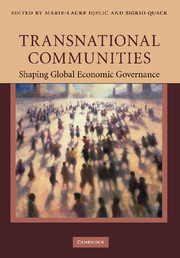Book contents
- Frontmatter
- Contents
- List of figures
- List of tables
- List of appendices
- Contributors
- Preface
- Part I Introduction
- Part II Classical communities with a transnational extension
- Part III Professional communities with a transnational extension
- Part IV Virtual communities
- Part V Transnational interest- or issue-based communities
- Part VI Conclusion
- 16 Transnational communities and their impact on the governance of business and economic activity
- Index
- References
16 - Transnational communities and their impact on the governance of business and economic activity
Published online by Cambridge University Press: 07 September 2010
- Frontmatter
- Contents
- List of figures
- List of tables
- List of appendices
- Contributors
- Preface
- Part I Introduction
- Part II Classical communities with a transnational extension
- Part III Professional communities with a transnational extension
- Part IV Virtual communities
- Part V Transnational interest- or issue-based communities
- Part VI Conclusion
- 16 Transnational communities and their impact on the governance of business and economic activity
- Index
- References
Summary
The collective endeavor that has culminated in the production of this volume has allowed us to explore an interesting diversity of empirical settings in which transnational communities could be identified and seemed to play a role. In this concluding chapter, we take stock of what we can learn from a systematic comparison of transnational communities and of their role in those very different settings. Through such a comparison, we get a clear picture of the peculiar nature of communities with a transnational scale and scope. In the first section of the conclusion, we outline some key findings in that regard. In the second section, we then reflect more particularly on the impact that transnational communities have on the governance of business and economic activity.
The nature of transnational communities: outlining some key findings
In the introduction to this volume, we suggested five structuring and defining features of transnational communities. First, they represent, for their members, one among several community affiliations. Second, members are cosmopolitans but usually of a “rooted” kind. Third, transnational communities are imagined communities of a fluid and dynamic nature. Fourth, they exhibit a fair amount of within-community diversity. Fifth and finally, transnational communities are time-bound, non-essential and non-permanent collectives. After our journey through a multiplicity of diverse empirical settings, we should reflect a bit more on those five defining features – asking ourselves, in particular, how they might play out in the governance activities of transnational communities.
- Type
- Chapter
- Information
- Transnational CommunitiesShaping Global Economic Governance, pp. 377 - 413Publisher: Cambridge University PressPrint publication year: 2010
References
- 10
- Cited by



